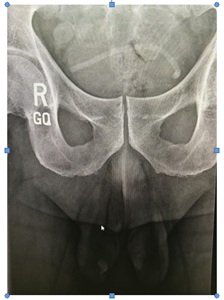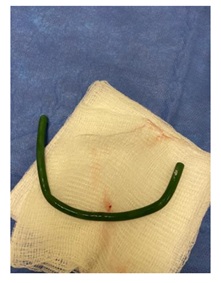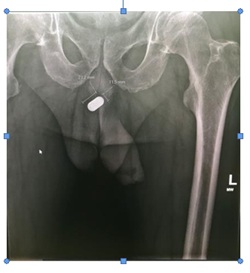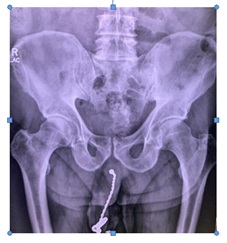
COVID or Coincidence: Retained Foreign Bodies Removed from the Urogenital Tract during the COVID-19 Pandemic
*Corresponding Author(s):
Kaitlin GonzalezNorthern Ontario School Of Medicine, 955 Oliver Rd, Thunder Bay, ON, P7B 5E1, Canada
Tel:+1 7059299144,
Email:kquinlan@nosm.ca
Abstract
Introduction: One aspect of health presently not well-explored in the perspective of the pandemic is sexual medicine and its impacts on the urogenital health of older adults. The World Health Organization cites sexual health and patterns of sexual practices to be influenced by a plethora of factors not limited to economic, biological, psychological, political, cultural, legal, historical, and spiritual; all of which have been impacted by the COVID-19 pandemic. Urethral polyembolokoilamania is an uncommon condition within the field of urology that occurs following the self-insertion of foreign bodies into the urogenital tract. Within a two-month period during the first wave of the pandemic, our physician group treated four cases of urethral polyembolokoilamania. This increase in prevalence poses a question of whether the cluster of cases can be attributed to the psychosocial-sexual effects resultant from COVID-19, or if it is merely a coincidence.
Methods: We report a case series of four older adult males who presented with retained foreign bodies at two local hospitals within Northern Ontario during the first wave of the COVID-19 pandemic.
Results: The First case included insertion of a plastic-coated electrical wire for self-pleasure. The electrical wire was grasped cystoscopically under spinal anesthesia. In the second case, we manually milked two AAA batteries from the urethra while the third battery was removed from bladder cystoscopically. In the third case, a 14-inch beaded urethral self-pleasure dilator was lodged in the urethral meatus. This dilator was pushed in further and removed with forceps. The last case involves hot melted candle wax poured into a urethra causing a first-degree burn to glans penis. Cystoscopy did not reveal any abnormalities.
Conclusion: It is difficult to say the cause, if any, of this cluster of cases. However, one begs to question if the otherwise rare occurrence of urethral foreign bodies at our local hospitals is related in part to the COVID-19 pandemic and resulting changes the sexual behaviour.
Keywords
COVID-19; Foreign bodies; Polyembolokoilamania; Sexual behavior
Introduction
In early 2020 the Corona Virus of 2019 (COVID-19) became a global pandemic. As part of staged plans to limit spread of the virus, local health authorities across the country increasingly restricted travel, public gatherings and human interactions. Two-meter physical distancing policies were established, facial coverings strongly recommended, and eventually mandated in most areas. Alike, retail establishments, restaurants, and offices sequentially closed for a period of time; increasing work capacity from home to limit in-person gatherings. Personnel across nearly every sector within Canada were impacted. Many temporary business closures early in the pandemic have persisted indefinitely, resulting in permanent job loss. Whether it was temporary at the height of the pandemic, or ongoing, individuals across most workforces have seen loss of work time during COVID-19. Prior to the pandemic the older adult demographic was projected to constitute over 25% of the workforce [1]. This loss of work time could be translated to increased leisure time for this particular age demographic.
The COVID-19 pandemic has raised health concerns across a variety of disciplines within medicine. With regards to the older adult population, there have been growing concerns related to the negative mental and physical health outcomes posed by social distancing [1]. During the pandemic older adults have become increasingly socially isolated and have subsequently experienced a disproportionate level of disruption to their social networks and relationships relative to their younger counterparts [1]. This is largely due to the higher likelihood of adverse health outcomes and mortality rates among older adults diagnosed with COVID-19 [1]. One aspect of health not well-explored in the perspective of the pandemic is sexual medicine and its impacts on urogenital health in older adults. The World Health Organization cites sexual health and patterns of sexual practices to be influenced by a plethora of factors not limited to economic, biological, psychological, political, religious, cultural, legal, historical and spiritual [2]. With the pandemic impacting nearly all aforementioned factors, it is expected that sexual behavior and tendencies during COVID-19 will change significantly. Although there has yet to be little evidence published, changes in sexual behavior during COVID-19 may also be due to having fewer in-person interactions. Prior to the pandemic, recreational sex was cited as a popular form of leisure, which has now been redefined by social distancing guidelines [3]. Therefore, it is inferred that individuals may employ different sexual practices in the setting of the pandemic.
Overall urethral polyembolokoilamania, also known as the self-insertion of foreign bodies into the urogenital tract, is a relatively uncommon condition [4]. Although several etiologies and motivations for the condition have been reported, most are related to sexual satisfaction [4]. The urethral manipulation that occurs with polyembolokoilamania causes prostatic stimulation and activation of hypogastric nerve afferents, resulting in sexual pleasure [4]. Within the span of two months during the height of the pandemic and self-isolation recommendations, two local hospitals in Northern Ontario: Timmins and Thunder Bay had four separate cases of retained foreign bodies within the older male urogenital tract. Serving as main health hubs for the Northwest and Northeast Local Health Integration Networks, our two hospitals service a catchment area of approximately 386,000 residents [5,6]. Within our regions, we rarely see one case of urethral polyembolokoilamania per year. We wonder if this cluster of cases is in part due to increased leisure time permitted by effects of the pandemic. Each of our patient cases did not have any history of neurocognitive decline or psychiatric illness.
Case 1: Electrical Wire Tubing
A 69-year-old male inserted a plastic-coated electrical wire into his urethra for reported self-pleasure purposes. The patient removed the wire from his urethra, but the tubing remained. He did not experience any urinary symptoms. After not passing the electrical wire tubing for two days, he decided to present to the emergency department. X-ray revealed the plastic tubing within the bladder (Figure 1). The plastic tubing was removed under spinal anesthesia via cystoscopy and grasping forceps (Figure 2). This patient was discharged with a one-week course of oral antibiotics. Unfortunately, this patient was lost to follow up. 
Figure 1: X-Ray of retained electrical wire tube.
 Figure 2: Retained electrical wire tube.
Figure 2: Retained electrical wire tube.
Case 2: Three AAA Batteries
A 77-year-old male presented to the emergency department due to an inability to void. On physical exam, this patient was found to have a AAA battery protruding from his urethra. Manual removal of the first battery with forceps revealed a second intra-urethral battery, which was removed in the same manner. A Post-Void Residual (PVR) post-extraction was found to be 800cc, indicating further obstruction. Therefore, a pelvic x-ray was completed revealing a third battery within the proximal urethra (Figure 3). This third battery was removed under spinal anesthesia with cystoscopy and Storz grasping forceps (Figure 4). Continuous bladder irrigation was done overnight. The patient was discharged forty-eight hours post-operative with an in-dwelling catheter and oral broad-spectrum antibiotics for two weeks. Post-catheter removal the patient’s PVR was high due to a urethral stricture. Stricture dilatation was complete, but insufficient three months post-operative. This patient has been referred for reconstructive urethroplasty. 
Figure 3: X-Ray of retained AAA battery.

Figure 4: Retained AAA battery.
Case 3: Metal Beaded Urethral Dilator
A 69-year-old male found he could not remove a self-inserted 14-inch metal beaded urethral self-pleasure dilator (Figure 5). When he presented, end of the last bead was seen at the urethral meatus, but was unreachable. The dilator was manually pushed further into the urethra and was subsequently dislodged with grasping forceps. No issues were identified at follow up.
 Figure 5: X-Ray of retained metal chain.
Figure 5: X-Ray of retained metal chain.
Case 4: Candle Wax
A 58-year-old male presented to the emergency department with a chief complaint of a painful penis. On further history, this man revealed he had poured hot melted candle wax into his urethra. He did not report any lower urinary tract symptoms or urinary retention. Physical exam demonstrated a first degree burn to the glans penis centered around the urethral meatus. Cystoscopy under local anesthesia with URO-jet did not identify any remnant wax or additional findings. An anterograde pyelogram also did not reveal any defects. PVR was less than 100cc. Polysporin ointment was prescribed for the minor burn. In follow-up four weeks later, PVR was within normal limits and the glans penis had healed well with no residual findings on exam.
Discussion
The spread of COVID-19 during sexual activity is a concern and therefore sex with out-of-household partners during the pandemic has been discouraged until means other than physical distancing can control the spread of the virus [7]. Not only has sex with out of household contacts been discouraged, but masturbation and ‘self-sex’ during the time of the pandemic have been endorsed by public health agencies across the country [7,8]. Further, public health authorities have proposed virtual sexual activities as an alternative means to self-sex in efforts to reduce the spread of COVID-19 within the area of sexual health. This is because sexual activity is recognized as an important aspect of human health to maintain emotional and physical well-being. Pornography consumption by popular pornographic websites have correspondingly seen increases in consumption in excess of 11-20% compared to pre-pandemic times [9,10]. Cross-sectional studies across age groups and demographics have also found individuals having less in-person sex and increased masturbation and self-sex alternatives [3,9]. Although there was an increase in solitary sexual satisfaction approaches in both sexes, the rate of this incidence was significantly higher in males than in females [4]. Interestingly, several studies have reported that males are more predisposed than females to initiate dyadic or solitary sexual activity [4].
As previously mentioned, COVID-19 pandemic has disproportionately impacted the social functioning of older adults [11]. This is further exacerbated by the digital gap that exists between younger and older adults, meaning that individuals over the age of 65 are less likely to access the aforementioned virtual alternatives to safe-sex. Older adults tend to experience digital exclusion because they opt to not utilize the internet, lack the network connectivity or prerequisite devices, or are inexperienced with technology [11]. For example, a study in 2020 during the height of the first-wave found that only 20% of individuals over the age of 65 reported participating in online social gatherings [11]. Furthermore, it is estimated that 30% of individuals ages 65 and older do not use the internet whatsoever. These statistics are even more striking for older adults living in long term care facilities, many of whom have been unable to visit with their family members and friends due to strict institutional lockdowns. A study based in Germany found that only 3% of individuals living in long term care facilities used internet-connected technology devices [11]. Given this, it is evident that older adults are particularly vulnerable to social exclusion as a result of the pandemic.
With this in mind, it is reasonable to assume that sexual behaviors during the time of pandemic will change due to physical distancing practices and the aforementioned recommendations of public health. Although it is hard to say, this cluster of cases of retained foreign bodies during the pandemic may represent changes in sex behavior. Preliminary literature in the area highlights incorporation of new activities within the sexual repertoires of individuals solely due to the pandemic [3]. This is in keeping with our hypothesis that these cases may represent an increase in self-pleasure activities as a result of increased leisure time and physical distancing due to the pandemic. Supporting our thought, in July of 2020, a group in British Columbia reported a similar case series of sexual injuries within a jurisdiction known to have a high proportion of elderly individuals during the time of the pandemic [12].
Conclusion
This case series explored four cases of older adult men with urethral polyembolokoilamania during the time of the pandemic. Further cross analysis with a thorough chart reviews would be required to delineate if these cases truly represents an increase in retained foreign body objects compared to pre-pandemic times. Nonetheless, it seems COVID-19 is impacting nearly every facet of life, including sexual and urological aspects of clinical medicine.
Acknowledgement
We acknowledge the Northern Ontario School of Medicine for their assistance in funding this publication.
References
- Monahan C, Macdonald J, Lytle A, Apriceno M, Levy SR (2020) COVID-19 and ageism: How positive and negative responses impact older adults and society. Am Psychol 75: 887-896.
- World Health Organization (2006) Defining sexual health: Report of a technical consultation on sexual health, 28-31 January 2002. WHO, Geneva, Switzerland.
- Lehmiller JJ, Garcia JR, Gesselman AN, Mark KP (2021) Less sex, but more sexual diversity: Changes in sexual behavior during the covid-19 coronavirus pandemic. Leisure Sciences 43.
- Chan G, Mamut A, Tatzel S, Welk B (2016) An unusual case of polyembolokoilamania: Urethral avulsion from foreign object use during sexual gratification. Can Urol Assoc J 10: 181-183.
- Thunder Bay Regional Health Sciences Centre (2020) About Our Region. Thunder Bay Regional Health Sciences Centre, Thunder Bay, Ontario, Canada.
- Timmins and District Hospital (2017) Paediatric Resident Electives with Timmins and District Hospital. Timmins and District Hospital, Timmins, Canada.
- Toronto Public Health (2020) COVID-19 Fact Sheet. Toronto Public Health, Toronto, Canada.
- BC Centre for Disease Control (2020) COVID-19 and Sex. BC Centre for Disease Control, BC, Canada.
- Li G, Tang D, Song B, Wang C, Qunshan S, et al. (2020) Impact of the COVID-19 Pandemic on Partner Relationships and Sexual and Reproductive Health: Cross-Sectional, Online Survey Study. J Med Internet Res 22: 20961.
- Psychology Today (2020) How the Pandemic Is Changing Pornography: COVID-19 is affecting porn production and porn searches on popular sites. Psychology Today, New York, USA.
- Seifert A, Cotten SR, Xie B (2021) A Double Burden of Exclusion? Digital and Social Exclusion of Older Adults in Times of COVID-19. J Gerontol B Psychol Sci Soc Sci 76: 99-103.
- Spooner J, Lee L, Kinahan J, Metcalfe M, Hoag N (2020) Male genitalia injuries: Unspoken collateral damage from the COVID-19 pandemic. Can Urol Assoc J 14: 294-296.
Citation: Trigo S, Gonzalez K, Ahmad A, Kotb A, Lang M, et al. (2021) COVID or Coincidence: Retained Foreign Bodies Removed from the Urogenital Tract During the COVID-19 Pandemic. J Gerontol Geriatr Med 7: 093.
Copyright: © 2021 Sabrina Trigo, et al. This is an open-access article distributed under the terms of the Creative Commons Attribution License, which permits unrestricted use, distribution, and reproduction in any medium, provided the original author and source are credited.

